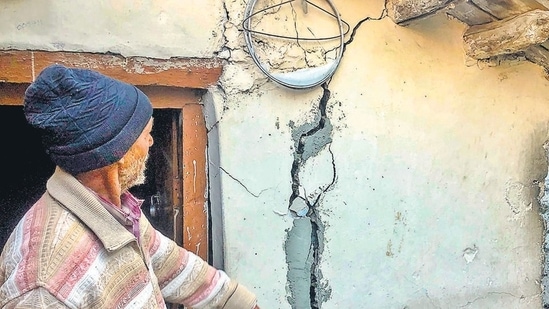Policies and People | Joshimath crisis: Invest in mountain-specific planning
There is an urgent need to develop land-use planning guidelines for mountain areas at the state-level, and raise public awareness about risks associated with urban development in ecologically fragile areas
The Joshimath land subsidence case has sparked an intense discussion on the threats India’s beautiful but fragile Himalayan towns face due to a lack of proper planning and a cadre of professionals trained in formulating plans for such eco-sensitive areas.

However, Joshimath-type episodes shouldn’t come as a surprise; it was waiting to happen. There have been comprehensive research studies and warnings about the bumper-to-bumper hydropower projects and mega infrastructure programmes in these ecologically fragile areas.
There have also been consistent demands for calculating the carrying capacity of Himalayan towns and meetings of the Himalayan states to chalk out a standard development road map. But unfortunately, nothing has come of these demands or meetings.
Over the years, urbanisation has emerged as a key driver of disaster risk in these areas, and this has been exacerbated in the era of the climate crisis.
A paper — Urban planning as an instrument for disaster risk reduction in the Uttarakhand Himalayas — in Mountain Research Development, a peer-reviewed open-access journal, elaborates on what exactly is the planning-related problem in the state.
The authors of the paper — Neelakshi Joshi, Wolfgang Wende and Prakash C Tiwari — write that planning tools are largely absent, there is a severe dearth of urban planning capacity at state and local levels, an absence of local-level risk knowledge and, unfortunately, a consistent public pushback against introducing developmental regulations.
For example, the state-level planning bodies — Uttarakhand Housing and Urban Development Authority, and the Town and Country Planning Organisation (TCPO) — are located in Dehradun, while the regional-level TCPO is in Haldwani. Neither is in mountainous areas, and they are spatially closer to the dominant urban development in the state's plain areas. This creates a problem of distance, both political and spatial, for mountainous urban centres' visibility in state-level urban planning discourse.
The case of Uttarakhand is further complicated because the devolution of power (74th Amendment Act of 1992) has not been completed and most functions still lie with state-level authorities. This presents a difficult situation for municipalities to have the responsibility to govern without the necessary capacity to do so.
Missing land-use maps
The researchers analysed the availability of land-use maps (a key planning tool), and were surprised to find that of the 115 urban centres in the state, only 18 had land-use maps.
The chart below gives a clear picture of the sorry status of planning in the state:
| Urban Centres | No. of Urban Centres | Population Size (% of total) |
| Total Urban Centres | 115 | 3,049,338 (100) |
| Plains Urban Centres | 76 | 2,608,350 (85.5) |
| Mountain Urban Centres | 39 | 440,988 (14.5) |
| Source: | Based on UHUDA n.d. | a)* Land-use plans that are valid beyond 2020. |
“This large absence of land use plans is indicative of a weak planning mechanism at the state level, as well as local levels. In mountains, this presents a worrying trend, because it indicates that urban development in risk-prone terrain is taking place without addressing the geophysical risks that are typically considered in land use planning,” write the authors.
In terms of addressing disaster risk in land use plans, national guidelines exist and provide a basic framework. However, similar guidelines at the state level in Uttarakhand are absent.
Weak implementation of building regulations
Alongside land-use plans, building regulations also play an important role in addressing disaster risk in the built environment.
The state has building regulations that emphasise the peculiarities of the mountain terrain and hazards. However, as is the case for land-use plans, municipalities have not been able to formulate building regulations and adopt state-level regulations. In addition, most municipalities have a very low capacity to implement any regulation.
The authors conclude that there is an urgent need to develop land use planning guidelines for mountain areas at the state level upon which local-level knowledge inputs can build. There is also a need to raise public awareness about risks associated with urban development and for citizens to demand reliable risk information and knowledge.
India’s mountain towns are facing a crisis of Himalayan proportions.
Only sound, ecologically friendly planning can save them. The key question is: Which mountain state will take the first concrete step to change the current development paradigm?
The views expressed are personal
All Access.
One Subscription.
Get 360° coverage—from daily headlines
to 100 year archives.



HT App & Website







